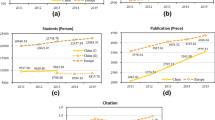Abstract
This paper presents a methodology for measuring the improvements in efficiency and adjustments in the scale of R&D (Research & Development) activities. For this purpose, this study decomposes academic productivity growth into components attributable to (1) world academic frontier change, (2) R&D efficiency change, (3) human capital accumulation, and (4) capital accumulation. The world academic frontier at each point in time is constructed using data envelopment analysis (DEA). This study calculates each of the above four components of academic productivity for 27 countries over 1990–2003, and finds that the components which contribute to academic productivity growth vary with the different countries’ characteristics and development stages. Human capital has more weight in terms of the quantity of academic research, and capital accumulation plays a more important role in the citation impact of academic research.
Similar content being viewed by others
References
Abramo, G., D’Angelo, N., Pugini, F. (2008), The measurement of Italian universities’ research productivity by a non parametric-bibliometric methodology, Scientometrics, 76(2): 225–244.
Adams, J., (1990), Fundamental stocks of knowledge and productivity growth, Journal of Political Economy, 98: 673–702.
Adams, J. D., Griliches, Z. (2000), Research productivity in a system of universities. In: Encaoua, D. (Ed.), The Economics and Econometrics of Innovation. Kluwer Academic Publishers, Boston.
Bonaccorsi, A., Dario, C. (2003), A robust nonparametric approach to the analysis of scientific productivity, Research Evaluation, 12: 47–69.
Bonaccorsi, A., Dario, C. (2004), Econometric approaches to the analysis of productivity of R&D systems, In: H. F. Moed, W. Glänzel, U. Schmoch (Eds), Handbook of Quantitative Science and Technology Research: The Use of Publication and Patent Statistics in Studies of S&T Systems (pp. 51–74). Dordrecht/Boston/London: Kluwer Academic Publisher.
Bonaccorsi, A., Daraio, C., Simar, L. (2006), Advanced indicators of productivity of universities. An application of robust nonparametric methods to Italian data, Scientometrics, 66(2): 389–410.
Caves, D., Christense, L., Diewert, W. (1982), The economic theory of index numbers and the measurement of input, output, and productivity, Econometrica, 50: 1393–1414.
Charnes, A., Cooper, W., Lewin, A., Seiford, L. M. (Eds) (1994), Data Envelopment Analysis: Theory, Methodology, and Application. Boston: Kluwer Academic Publishers.
Charnes, A., Cooper, W. W., Rhodes, E. (1978), Measuring the efficiency of decision making units, European Journal of Operational Research, 2: 429–444.
Crespi, G. A., Geuna, A. (2008), An empirical study of scientific production: A cross country analysis, 1981–2002, Research Policy, 37: 565–579.
European Commission (2003), Third Edition of the European Report on Science and Technology Indicators. Luxembourg: Office for Official Publications of the European Communities.
Färe, R., Grosskopf, S., Norris, M., Zhang, Z. (1994), Productivity growth, technical progress, and efficiency change in industrialized countries, American Economic Review, 84(1): 66–83.
Farrell, M. J. (1957), The measurement of productive efficiency, Journal of the Royal Statistical Society, Series A CXX(3): 253–290.
Goto, A., Suzuki, K. (1989), R&D capital, rate of return on R&D investment and spillover of R&D in Japanese manufacturing industries, Review of Economics and Statistics, 71: 555–564.
Grilliches, Z. (1979), Issues in assessing the contribution of research and development to productivity growth, The Bell Journal of Economics, 10: 92–116.
Guellec, D., van Pottelsberghe de la Potterie, B. (2004), From R&D to productivity growth: Do the institutional settings and the source of funds of R&D matter? Oxford Bulletin of Economics and Statistics, 66(3): 353–378.
King, D. A. (2004), The scientific impact of nations, Nature, 430: 311–316.
Korhonen, P., Tainio, R., Wallenius, J. (2001), Value efficiency analysis of academic research, European Journal of Operational Research, 130: 121–132.
Kumar, S., Russell, R. R. (2002), Technological change, technological catch-up, and capital deepening: Relative contributions to growth and convergence, American Economic Review, 92(3): 527–548.
May, R. M. (1997), The scientific wealth of nations, Science, 275: 793–796.
Meng, W., Hu, Z., Liu, W. (2006), Efficiency Evaluation of Basic Research in China, Scientometrics, 69(1): 85–101.
National Science Board (2008). Science and Engineering Indicators 2008. Arlington, VA: NSF.
National Science Indicators on Diskette, Thomson Scientific Inc., USA.
OECD. (2008). OECD Science, Technology and Industry Outlook. Paris: OECD.
Rousseau S., Rousseau, R. (1997), Data envelopment analysis as a tool for constructing scientometrics indicators, Scientometrics, 40(1): 45–56.
Rousseau, S., Rousseau, R. (1998), The scientific wealth of European nations: Taking effectiveness into account, Scientometrics, 42(1): 75–87.
Sharma, S., Thomas, V. J. (2008), Inter-country R&D efficiency analysis: An application of data envelopment analysis, Scientometrics, 76(3): 483–501.
Shelton, R. D. (2008), Relations between national research investments inputs and publication outputs: Application to the American Paradox, Scientometrics, 74(2): 191–205.
SOARES DE MELLO, J. C. C. B., GOMES, E. G., ANGULO-MEZA, L., SOARES DE MELLO, M. H. C., SOARES DE MELLO, A. J. R. (2006), Engineering Post-graduate programmes: A quality and productivity analysis, Studies in Educational Evaluation, 32: 136–152.
Thursby, J. G., Kemp, S. (2002), Growth and productive efficiency of university intellectual property licensing, Research Policy, 31:109–124.
Thursby, J., Thursby, M. (2002), Who is selling the ivory tower? Sources of growth in university licensing, Management Science, 48(1): 90–104.
Wang, E. C., Huang, W. (2007), Relative efficiency of R&D activities: A cross-country study accounting for environmental factors in the DEA approach, Research Policy, 36: 260–273.
Worthington, A. C., Lee, B. L. (2008), Efficiency, technology and productivity change in Australian universities 1998–2003, Economics of Education Review, 27(3): 285–298.
Author information
Authors and Affiliations
Corresponding author
Rights and permissions
About this article
Cite this article
Hung, WC., Lee, LC. & Tsai, MH. An international comparison of relative contributions to academic productivity. Scientometrics 81, 703–718 (2009). https://doi.org/10.1007/s11192-008-2210-9
Received:
Published:
Issue Date:
DOI: https://doi.org/10.1007/s11192-008-2210-9




